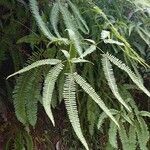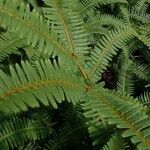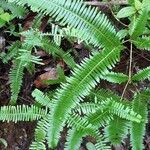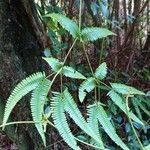Plants terrestrial or epilithic. Rhizome rooting at irregular intervals, wide-creeping, irregularly branched, corneous, castaneous, to 3 mm in diameter, initially moderately set with stellate hairs, glabrous later, hairs crustaceous, castaneous, sessile or short-stalked, rays uni-or pluricellular, often branched, uniseriate, apical cell of the terminal ray acicular or narrowly obovate and thin-walled, to 2.8 mm long. Fronds spaced, to 105 mm apart, erect or scandent, with indeterminate growth; stipe firm, yellow to brown, stramineous higher up, terete, to 1.1 m long, to 5 mm in diameter, initially closely set with hairs, hairs chartaceous to thinly crustaceous, castaneous, sessile, rays uni-or pluricellular, uniseriate, terminal ray much longer than the rest, of which the apical cell may be acicular or narrowly obovate, to 4 mm long; lamina pinnately branched, with one or more consecutive storeys of consecutive pinna pairs arising from each side of the terminal rachis bud, each bifurcation also flanked by a pair of accessory branches; rachis yellow, brown or stramineous, terete, to 4.2 mm in diameter, initially closely set with scales similar to those on the stipe, also with smaller hairs at the point where the pinnae branch from the rachis, hairs short-stalked, stellate, rays simple or branched, straight or twisted, to 1 mm long; pinnae reniform to transversely broadly elliptic in outline, to 3 times pseudo-dichotomously branched, with a dormant bud in the axil of each bifurcation, pinna-rachis branches terete or adaxially slightly flattened, initially moderately scaled, glabrous later, scales stramineous, stellate, to 1.8 mm long; ultimate branches adaxially convex, pectinately pinnatifid, inequilaterally narrowly lanceolate to linear-acuminate, to 220 mm long, to 40 mm wide, basal acroscopic segments shorter than those higher up, basal basiscopic segment enlarged; rachis and dormant buds densely set with crustaceous, ferrugineous to castaneous, stellate hairs similar to those on the rhizome, each bud subtended by a pair of simple or lobed pseudo-stipules; accessory branch pairs flank each pinna pair and consecutive pinna pseudo-dichotomies, adaxially shallowly sulcate, sessile, pectinately pinnatifid, narrowly lanceolate, to 180 mm long, to 43 mm wide; segments firmly herbaceous, linear-acuminate to linear-obtuse, entire, emarginate, to 20 mm long, to 4 mm wide, glabrous adaxially, abaxially with ferrugineous, stellate scales along the costa and with 2-celled hairs along the veins. Venation catadromous, pinnately forked, ending in the margin. Sori superficial, inframedial on acroscopic vein branches, with 8-15 sporangia per sorus, exindusiate. Sporangium short-stalked, multiseriate, annulus oblique, complete. Spores yellow, numerous, tetrahedral, trilete, with prolonged angles, rugulose, foveolate, to 45 µm in equatorial diameter.
More
Rhizome 1-5 mm in diameter, when young set with hairs up to 2 mm long. Fronds spaced 60-200 mm apart, bifurcate to reniform-lunate in outline with 1-3 levels of false dichotomy in each lateral branch system arising from each side of terminal bud; only stipule-like, deeply pinnatifid pinnae (up to 120 x 40 mm), and ultimate branches or false dichotomies bearing foliar segments; stipe stramineous to light reddish brown, glabrous, up to 700 x 4 mm; aborted apical buds set with reddish brown hairs; pinnules linear, sessile, up to 30 x 5 mm, confluent at their broadened bases, apices emarginate, glabrous. Sori superficial, consisting of a single sporangium or groups of 2-10.
Rhizome (1.5–) 2–4 mm diam.; internodes to 6 cm long. Stipes 10–82 cm or more long, glabrous. Rachis clothed at first with brown branched hairs, glabrescent. Ultimate segments linear, 18–40 (–70) mm long, 3–5 mm wide, divided almost to midrib, glabrous above, clothed below with branched hairs near base of midrib and minute oblong obtuse brown glands along veins or more rarely with hairs along midrib and veins; undersurface slightly to very glaucous. Sorus length one-quarter to one-third the distance from midrib to margin. Sporangia 0.2–0.25 mm diam., pale yellow-brown.
Rhizome creeping, set with multicellular hairs. Fronds with a pair of stipule-like pinnae flanking primary and often secondary bifurcations of frond. Pinnules linear, sessile, up to 30 x 5 mm. Sporangia single or in groups of 2-15 on veins.
A fern. It has a stout creeping rhizome or underground stem. It grows 2 m high and spreads 1.5 m wide. The fronds form dense thickets. The fronds have 25-60 pairs of narrow segments.





